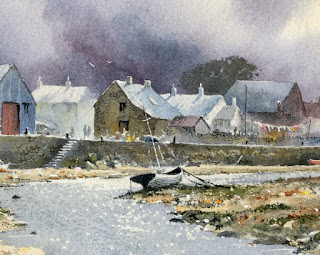After a week of absolutely atrocious weather in the Italian Dolomites it’s nice to be back in sunny Wales for a day or two. Although I managed a number of useful sketches, without any views because of dense mist and lashing rain for much of the time it was a little annoying, especially when you know the scenery is spectacular. The previous week at Lake Garda we suffered from intense heat during a group painting holiday, but everyone remained cheerful, kept painting and put up with all that sunshine.

On Monday evening (10th July) I will be giving a talk at the launch of my Arctic Light book at Stanfords Map Shop in Covent Garden, London. It’s a fabulous place for maps and guidebooks for all over the world. There are still a number of places left, and if you wish to come along, then please get in touch with Mary Ellingham at Search Press on 01892 510 850, or marye@searchpress.com
Although Arctic Light it is not a how-to-paint book, it is crammed with watercolours and sketches with a great many examples of the way atmosphere and light can be depicted in landscapes. This time I have also included many works showing wildlife, both animals and birds, which can make a real difference to a painting even if portrayed in a small scale within the composition. You can see more details at my website.
Next week I shall be demonstrating for St Cuthberts Mill at the annual Patchings Art Festival on the Thursday, Friday and Saturday, using the marvellous Saunders Waterford papers in the St Cuthberts Mill Marquee. The festival is on from 13th to 16th July inclusive and is highly recommended for its wealth of demonstrating artists, crafts and art materials, so do come along and have a chat. For further information on the event see Patchings Art Festival. We will also have a stand near the marquee with a number of my paintings, books, DVDs, etc, so hopefully I’ll see you there.





